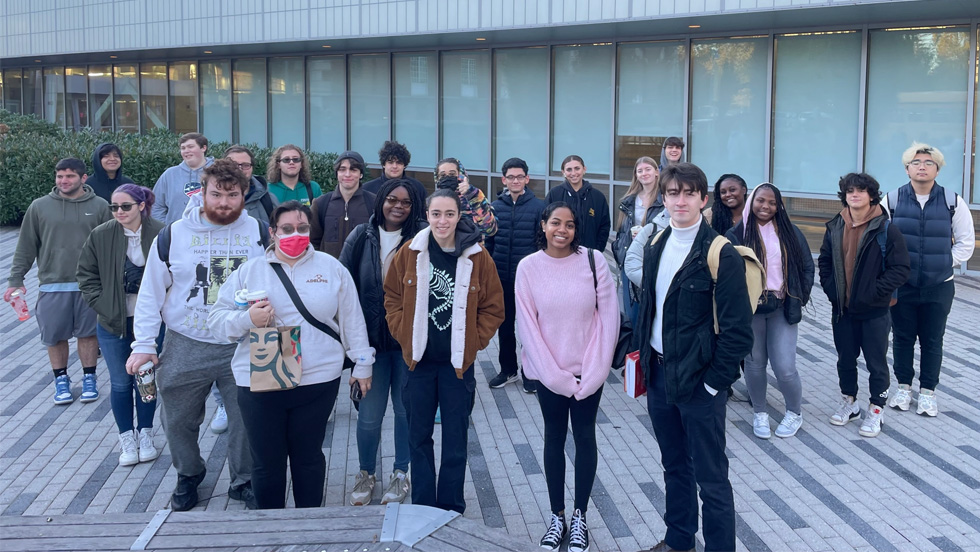
A First-Year Seminar collaboration connected astrophysics with creative writing.
How long would it take an AI robotic dog to reach a celestial body? Is it possible for space aliens to get home in time to save their family? And can cannabis smoke aid in time travel?
These were the formulas and scientific dilemmas under consideration in Fall 2023 when Kelly Swartz, PhD, assistant professor of English, and Matthew Wright, PhD, associate professor and chair of the Department of Physics, both in the College of Arts and Sciences, paired as part of a new cohort model being piloted in the First-Year Seminar (FYS). It offers incoming students the opportunity to explore topics from multiple perspectives.
The two, who had not met before, were matched by Salvatore Petrilli ’05, EdD, associate dean for academic operations and general education in the College and FYS coordinator. In this case, the interdisciplinary classes included Dr. Swartz’s exploration of how philosophy, modern science and technology inform 20th- and 21st-century science fiction. Dr. Wright’s class focused on helping students develop their problem-solving skills, exploring a range of interesting scientific and societal questions, such as: What’s the yearly economic impact of herding sheep? Together, the professors guided their students to use collaborative problem-solving in composing their own works of science fiction.
In keeping with the program, Drs. Wright and Swartz took their students—24 in each class—on a field trip to Brookhaven National Laboratory. Dr. Swartz said the trip helped her students who were reading science fiction about expensive technology but had never seen anything like the particle accelerators. “It was a real eye-opener for many students in terms of how large-scale, government-funded scientific research actually gets produced,” she said.
Drs. Wright and Swartz each taught separately for two thirds of the semester, then merged for a final joint project: writing a 25-page science fiction story. It required working in groups of four, two students from each class, and was a significant part of their grade.
According to Dr. Swartz, the students were skeptical at first. Because her class had been reading science fiction all semester and so were comfortable with the genre, Dr. Wright’s class only read the short story The Great Silence by Ted Chiang, which Dr. Swartz’s class also read. The professors chose the story together. “We met throughout the summer and it was really fun to work with Matt because, among other things, he got really into reading science fiction,” Dr. Swartz said.
They gave the students structure, but also a lot of freedom. “Part of the goal was for each group to come up with the way that they were going to tackle this problem together,” she noted.
Dr. Wright added, “In general, students hate group work because the contributions can be uneven. But when you get outside of academics and you go into the industry, you’re evaluated almost exclusively on your group work, so it really is an important skill to develop, especially in science.”
In addition to creativity, the stories involved logic. For instance, Dr. Wright said one was about space travel and Dr. Swartz’s students put the sequence of events in an order that wasn’t possible with the speed of light.
“We calculated the distances between various stars to determine how many years it would actually take for a rocket ship to travel from Earth to that star, and it actually helped their story quite a bit. By going through some of the numbers, they were able to really focus on what was important, and that made their story better,” Dr. Wright said.
Group Solutions
Gabriella Pedone, a first-year nursing student who was in Dr. Wright’s class, said that in the final project, each student in the groups had a different role. Her group wrote about space aliens. “Their spaceship got shot down and I had to figure out the speed and distance to move the aliens to another planet,” she said, adding that she’s continued to use the math formulas she learned in Dr. Wright’s class in her nursing classes. “We would have workshop days and meet with our partners. It was a great way to end the semester because us working together was just amazing.”
Hugo Ledesma, a first-year computer science major, took Dr. Swartz’s class because he’s a science fiction reader. He said he enjoyed working with the physics students who contributed the “realistic elements while we science fiction students worked on the more creative and writing aspects.”
Merged Approaches
Dr. Swartz said the co-teaching experiment was a success. “I think many of the students in both classes were pleasantly surprised at the creative work they accomplished collaboratively. They saw that Matt as a scientist and I as a humanities professor approach problems differently, but both of our approaches are useful when writing sci-fi.”